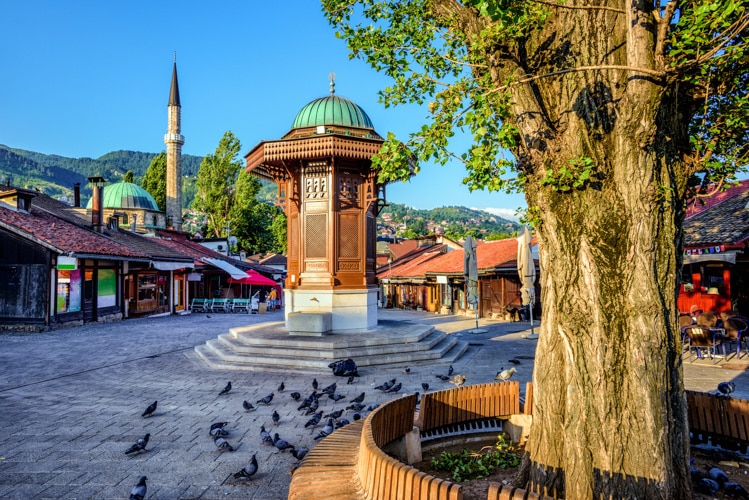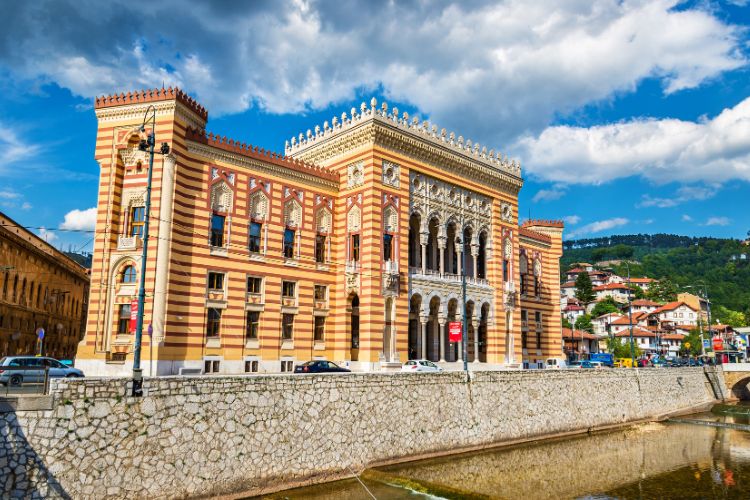
Go World Travel is reader-supported and may earn a commission from purchases made through links in this piece.
I am one of the fortunate few who has had the pleasure of visiting Sarajevo on a frequent basis. Sarajevo (and Bosnia and Herzegovina as a whole) is an often overlooked part of the world for the everyday traveler. To be honest, it’s their loss.
Whether it is the reputation of the 1990s war, more frequented locations in Western Europe, or simply the logistics of getting there, many people don’t take the time to visit.
While I do believe this is changing, it remains that Sarajevo is a great place to get acclimated to Bosnia and as a staging point to explore the rest of this beautiful country. I have been coming back to the “Jerusalem of Europe” since my childhood. It always mesmerizes me as few locations can.

The Jerusalem of Europe
To me, Sarajevo is the Jerusalem of its respective continent, but it is so much more. It’s a place where East clashes with West, where religions occupy the same city blocks (often with a synagogue sharing the same corners as churches and mosques), and where ethnicities melt together in a wonderful way (or boil over, in many cases), from the center of the town out to the valleys and throughout the surrounding hills.
Sarajevo represents the past, present, and future of Europe, a place of strong cultural traditions, a wariness of outsiders and coming together to truly enjoy life amidst it all despite the residents’ struggles. It’s the perfect metaphor for not only the Balkans as a whole but the entire continent of Europe. This is why Sarajevo is “The Most European City” to me.
Best Tips & Tools to Plan Your Trip
Flying into the unassuming international airport of Sarajevo, you notice the beautiful hills, mountains and valleys that make up the countryside around Sarajevo. You also notice relics of earlier times, like the 1984 Winter Olympics infrastructure still standing, as well as the up-and-coming industry near the airport and along the major routes in and out of the city.
Sarajevo is not an immense city by any means, but from above, it looks enormous. The city spreads from the main west to east central corridor along the Miljacka River and penetrates the various valleys along the way.
It connects to adjacent towns such as Ilidža and Vogošća, with roads and rivers in all directions seemingly connecting to the rest of Bosnia like a beating heart. From the first glimpse one takes of Sarajevo, one can tell it has so much more in store than most cities of its size.

Stunning Ilidža and Its Springs
One of our recent visits to Sarajevo found us staying at Hotel Hills in the Ilidža, where we have family nearby. It’s a stunning small town just outside the western edge of Sarajevo proper. There are various natural springs (such as Vrelo Bosne), providing a calming backdrop and beautiful trails to hike along.
Due to the springs, the Roman Empire built a frontier camp called Aquae Sulphurae two thousand years ago. Although they never truly subjugated the Balkans like they did so many other regions, Aquae Sulphurae remained a settlement for centuries, and the curative properties of the springs attracted various visitors.
The outsider influence is evident from the German and Austrian architecture on the buildings in the area. They showcase how visitors from other regions in Europe descended on this beautiful region throughout the 1800s, especially when the Ottomans were driven out of Sarajevo in 1878, which continued to bring Western European influence well into the 1900s and into the modern era.
The Austro-Hungarian architecture and other remnants of Western Europe paired with the legendary Bosnian hospitality (regardless of religious group or ethnicity) always stand out the most to me.
The springs of Ilidža, such as Vrelo Bosne, as well as the hills and mountains surrounding Sarajevo remind me of the mountain towns of my current home, Colorado, but with minarets, synagogues, and church steeples sitting comfortably below snow-capped peaks instead.

The Spirit of Sarajevo
However beautiful and enjoyable this recent trip to Sarajevo and the Balkans was, it was merely a preview for the constant East and West clash and coming together that the area truly represents.
From seeing Bosniak members of our family in Sarajevo to seeing the legacy of the West along with modern malls, bars, breweries and fantastic restaurants throughout the city, the spirit of Sarajevo and the Balkans was imprinted on my heart forever.
I returned to Sarajevo just a few years later for a conference. This time my husband and I stayed in the center of the city at Hotel Europe. It’s a beautiful and inspiring hotel that was heavily destroyed during the war in the early 1990s. Eventually, it was renovated above and beyond its former glory.
It sits on the edge of the Eastern European part of central downtown known as the Baščaršija. To say the location of Hotel Europe was a microcosm of Sarajevo would be an understatement.
The clash of East and West hit home even more significantly than the previous trip to the city. As soon as we got off the plane, we saw hijabs and burkas of residents of Saudi Arabia, the UAE, and elsewhere throughout the Middle East after new routes recently opened up from those areas.

Middle East Influence
Juxtaposing the Middle Eastern travelers and others from East Asia, were plenty of Balkan residents as well as the trendiest Western Europeans. Upon checking in to the hotel we could see Ottoman ruins (Tašlihan) just outside our window, originally built in the 1500s. This was straight to our east.
To our West was a different world. It seemed like any Western European city filled with trendy bars, restaurants, and, overall, a more cosmopolitan feel. Rakija, beer and other liquors from around the world provided a different feel than the few blocks to our east.
On the afternoon of our first day back there we went east. Our primary driver to do so was the urge for good coffee and Cevapi. The latter is a Bosnian specialty of grilled beef sausages with onions served on a soft bread called lepinja. It’s truly one of the best meals you can have.

Traditional Eastern Baščaršija
Walking through the Baščaršija makes you feel like you’ve been transported to the Ottoman Empire. There are shops filled with traditional wares, more incredibly hospitable people and traditional Bosnian food and drink.
With the mix of traditional Bosnians, Europeans and other Westerners, as well as Muslim women wearing hijabs and burkas, it felt like we were in the Souq Waqif in Qatar rather than an actual European country.
To many, it may be a culture shock, but I absolutely love it. That day, we walked to the Sebilj, one of the traditional Islamic fountains from the Ottoman era. We then grabbed fresh squeezed pomegranate juice and settled down for some phenomenal hookah.
As we relaxed and enjoyed the hookah, we met fellow Americans from Idaho also exploring the world and expanding their horizons. Sitting there in the shade on that beautiful summer day, taking in all the sights and sounds, we experienced what a unique place Sarajevo truly is.

The Modern West
Later, when we attended the conference, we took turns going from east to west. We had lunch in the Baščaršija, exploring some of the more modern areas of Sarajevo and seemingly bringing it all together at Hotel Saraj. I could not recommend this location enough for dinner and other events.
As you look over the city to the west and see all of it from various angles, it’s the perfect encapsulation of East and West. Especially as the sun sets. Walking out of Hotel Europe and simply going right instead of left introduced us to a whole new world.
Getting drinks in the Baščaršija is a rarity but to the west of Hotel Europe, it’s all around. One evening we grabbed various flavors of Rakija as a small group at the Tesla Pub, named after the famous Serbian inventor. Naturally, this felt just as comfortable as hookah in the Baščaršija or sitting and watching the sunset at the Hotel Saraj.
The most visible difference was that the clothing was much less conservative, just a few minutes walk from where Archduke Ferdinand was assassinated in 1914, sparking a worldwide conflict that had been building up for years.

East and West Merge
On this Western side, there are so many more examples of churches, synagogues, and other facets of the traditional West and the architecture from various periods.
Sarajevo City Hall, formerly a library and heavily destroyed during the war, has been completely rebuilt. It has huge flair merging east and west in its unusual triangular shape and yellow facade.
From the Roman times to the Ottoman era to the World Wars and into the modern era, this city and the region are no strangers to war. However, the legacy is quickly fading as Sarajevo becomes a symbol of Eastern and Western heritages merging.
There are other scars of the war in the 1990s, but with each visit to the city, I see less of the war (both physically and within the hearts of the residents). I see more of the hospitality of the people, the visitors from around the world and the stunning beauty that few other cities can match. In so many ways, the city and region are healing and new generations are looking towards the future with excitement.
Sarajevo: A Go-To City
I could go on and on, citing separate examples for various parts of the city and highlighting the vastly different cultures and mindsets that permeate throughout.
However, I end by thanking Sarajevo for being what makes the Balkan region incomparable. If you want to get the most out of Europe and beyond in a single location, this is your go-to city.
Author Bio: Djenita Svinjar is an attorney and entrepreneur residing in Denver, Colorado. When not practicing law, she loves to write and explore the world around her. Originally hailing from the Balkans, she came to the United States in 1994 as a child refugee during the Bosnian War. Djenita credits her love of travel and learning about various cultures to her background and upbringing.
- Fiddle, Flutes & Pubs: A Musical Journey Through Northern Ireland & County Donegal - July 14, 2025
- Tokyo vs. Osaka: The Ultimate Face-Off for First-Time Visitors to Japan - July 14, 2025
- When Is the Best Time to Visit Iceland? Find Your Perfect Month for Budget, Weather, and Activities - July 14, 2025

